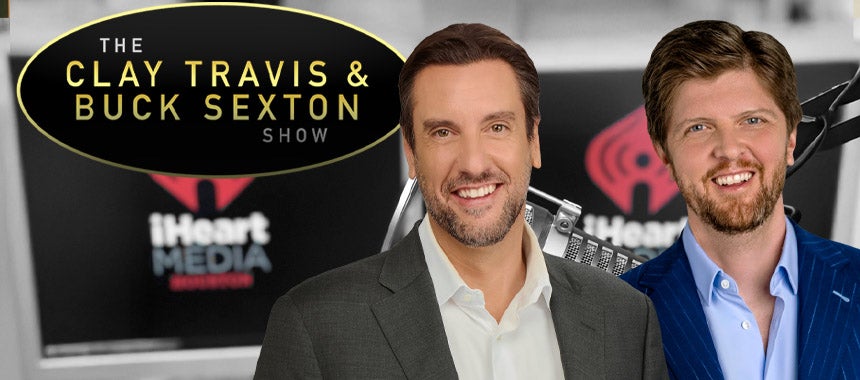New Evidence Affirms an Abject, Inexcusable Police Failure in Uvalde
21 Jun 2022
CLAY: We talked about Uvalde and the school shooting there a great deal when it happened — the consequences, the details — and it appears that there now is a full vetting that is coming due, and it is that Uvalde police — commanders at a minimum — completely dropped the ball in their response here. And we want you to be able to hear this audio that was just released in recent hours here.
This is (Texas Department of Public Safety Director) Steve McCraw letting you know all of the details going on in the investigation surrounding Uvalde police response to that shooting. This is going to be chilling, this is going to be tough to hear, but we need an accurate rendition of what truly happened, and the police — the police — did not do the best at all, even close to it, protecting these young kids and those teachers. Listen.
Abject, inexcusable failure from on the scene Police command at Uvalde massacre. This abysmal response will be studied for years as what *not to do* during an active shooter situation
pic.twitter.com/FNCaJ8Rnef— Buck Sexton (@BuckSexton) June 21, 2022
CLAY: Buck, you’ve watched some of this video as they have released actually the scene video from inside of the school. You’ve actually trained in some of these situations. You recognize better than most would the type of guns that the police had, that they were equipped with, also the protective shields and whatnot. What — based on the videos and the data and the reports coming out now — is your take?
BUCK: This was abject failure and catastrophic misapplication of tactical doctrine. So, here’s the very fundamental and — unfortunately, given the stakes here — horrific error that was made. There was a mind-set — and this comes across. I watched the Senate committee, the Texas Senate Committee to Protect All Texans live today, when they went through step by step, the latest information, it was illuminating in some ways, Clay.
For example, why was there all that misreporting in the beginning about the school resource officer confronting the gunman? That seemed like a detail that you couldn’t get wrong in good faith. Well, in this case — meaning the press reporting on it — it was because a resource officer was not on scene but responded to the scene and did confront an adult outside the building who he at first thought may be the shooter but was not.
It was just a teacher who was outside the building. But so that was where there was this initial… So there were good-faith reporting errors either on the part of the law enforcement or… Okay. But getting to the much more important component of this, the doctrine post-Columbine for active shooter is “stop the threat.” It’s as straightforward as anybody can imagine. You have someone who is actively trying to kill human beings, who are — in the case of the school — unarmed and defenseless, you go until it’s stopped.
That means law enforcement officers take risks. That means that police on the scene are going to get shot at, and some of them may be hit. That is the doctrine. What the commander on the scene applied to this was, “This is a barricaded shooter situation,” and that then explains why the tactical decisions were made. Remember, over an hour of waiting — an hour of children bleeding out in that classroom, an hour of ongoing shooting.
CLAY: 911 calls from inside.
They had long guns and a ballistic shield. Absolutely zero conceivable excuse for them to sit in that hallway and do nothing while children were being murdered https://t.co/72yo0fVWsD
— Buck Sexton (@BuckSexton) June 21, 2022
BUCK: Yes. So they applied barricaded shooter doctrine. So, that means, “et up a cordon, get a negotiator, see if you can get them to come out without an exchange of gunfire with law enforcement, necessarily.” This was not a crazy person who had locked himself in an attic and said, “If anyone comes in here, I’m going to shoot them.” This was a mass murdering psychopath still on scene, still firing his gun.
The fact that there were multiple instances, Clay, as you pointed out, of 911 calls being made from inside the classroom, of gunfire from inside the classroom, I do not understand… Now, I know they want to make this about command, and I know we have a lot of law enforcement. we’ve got Army Rangers who saw seven tours listening right now. We’ve got SWAT team commanders listening right now.
They know a heck of a lot more about this than I do. But I don’t understand how anybody in that hallway where they had long guns… They had AR-15s too. They had ballistic shields. Clay, they had four ballistic shields stacked up. They had multiple long guns! They had body armor too. You got an 18-year-old lunatic in there shooting people, and you don’t go in? I don’t understand how they don’t override command and say, “Sorry, sir, you can fire us but we’re going in.”
CLAY: It sounds like on some level that’s what finally happened. But I would love to get calls — and we’ve done this before as some of the details came out — 800-282-2882. I only want, to Buck’s point, people who have either found themselves in these situations before or have been through so many different training exercises. As all these details are coming out, Buck, I just can’t stop thinking about the 911 calls.
And if you are a police officer and you are aware that there are kids calling from inside of these classrooms, teachers calling from inside of these classrooms, isn’t this why you become a police officer? If you crystallized, I think, for the vast majority of people out there who go into law enforcement, it’s very rare that you get an opportunity is to protect the young and innocent from a heinous madman.
This is why, I think, why you become a police officer, because there are children in danger, because there are female teachers in danger, because there are people who are not as strong as you are that are in danger and you are there as their shield. You are there as their protector. I cannot imagine sitting outside of that classroom — and, frankly, you know what? Neither could those parents. Those parents were willing to go in unarmed, some of them, and try to take their chances to protect their kids.
 And I’m afraid of the details that are gonna come out. The number of kids that were shot and the number of teachers that were shot that could have survived if they had gone in that first two or three minutes and actually confronted this gunman, it makes me sick to my stomach. And I bet it makes a huge number of people out there listening to us right now who are in law enforcement absolutely sick to their stomachs.
And I’m afraid of the details that are gonna come out. The number of kids that were shot and the number of teachers that were shot that could have survived if they had gone in that first two or three minutes and actually confronted this gunman, it makes me sick to my stomach. And I bet it makes a huge number of people out there listening to us right now who are in law enforcement absolutely sick to their stomachs.
So here’s the question I have, Buck: What happens now? Are there consequences for this police officer, this commander on the scene who made such disastrous decisions, as you pointed out — treated this like a hostage-barricade situation as opposed to an active shooter? And how was he not overruled I think is a question that is echoing through many of our listeners right now.
BUCK: There’s gonna be a lot of continued, I think, debate and analysis over this from within the immediate law enforcement community that was on the scene there but also I think that this will be studied in a very similar way to Columbine, right? Columbine was, they applied the training they had, and training was absolutely wrong for the situation. Now, that’s a different thing. What we have here is the misapplication of training doctrine to the specific situation at hand.
It’s not that law enforcement hadn’t had the training and would not have been able to respond differently based on their training. In this case it’s, “We think we have a barricaded shooter and are gonna treat it as such,” when it’s really an active shooter. That’s a huge… But then to your other point, Clay, not only all of the law enforcement community members listening to this right now… I honestly believe all the parents listening to this right now who have a…
Look, some people have a comfort and a familiarity with firearms, know how to handle themselves with a firearm. And I just know right now there are parents across the country listening, saying, “Forget about being a law enforcement officer, tactics and training. There are 911 calls being made and they’re still shooting from inside of a school building, and I’m on the scene? Give me my 12-gauge, man! I’m going in,” and I believe they would do it.
I don’t think that that’s bravado. I believe that, and I know that, and so when you think about it in that context, you wonder, I guess just command-and-control in that hallway for those officers. Because I also believe that those officers… Maybe I want to believe that it’s not that they were scared they were gonna get shot. It’s that they didn’t want to be the one that broke orders and made it worse. So I think it’s tactical misapplication. I want to believe that instead of, “Oh, I don’t want to get shot trying to save these kids.” But I also leave some of this to a law enforcement community that’s listening and what do they think.
CLAY: And we also don’t know what those later-arriving officers were told on the scene. Some of those guys may have gotten there and they may have said, “Man, it’s awful. All the kids in the classroom are dead, and this guy has barricaded himself in now.”
 BUCK: That’s right. That’s right.
BUCK: That’s right. That’s right.
CLAY: So they may not —
BUCK: If they told the BORTAC team that, for example, “Everyone in the room is dead. We’re waiting to see if we can get in get this guy,” then there’s no urgency. The problem is when you hear gunfire, there’s urgency. So we have to know it.
CLAY: When you hear that gunfire and, oh, by the way, I just think — and again we don’t know exactly, but the 911 calls — when you’ve got 12 or 14 911 calls being made from inside of that classroom, I have to believe that the vast majority of those police officers did not know about exactly what was taking place there. But you know who should have, is the guy who was in command, and there are gonna be an all of you lot of questions about what should happen to him.
And also think about this: Much of the discussion has surrounded laws that need to be changed, and that debate is still ongoing. But the story of Uvalde to me is, the police were there within two or three minutes of the guy entering into the classroom. How much different of a story is this if, in four minutes, they go in and they take this guy out? How many more people are still alive? How much different is the discussion? Because then, by the way, one guy with a gun — a couple of guys with guns were able to confront him as opposed to here where they say, “Oh, the police didn’t do their job, they sat outside, we’ve gotta have less guns.”
 BUCK: To wait when you have four trained law enforcement officers with ballistic shields and bullet-resistant vests, Kevlar vests on and long guns, is inexcusable. It’s just inexcusable. The basis for this… This guy, they weren’t going up against some kind of a cyborg. He’s an 18-year-old kid who’s murdering defenseless children. The parents somehow, Clay, knew on the perimeter. They knew that not enough was being done, which I think is also a haunting part of this.
BUCK: To wait when you have four trained law enforcement officers with ballistic shields and bullet-resistant vests, Kevlar vests on and long guns, is inexcusable. It’s just inexcusable. The basis for this… This guy, they weren’t going up against some kind of a cyborg. He’s an 18-year-old kid who’s murdering defenseless children. The parents somehow, Clay, knew on the perimeter. They knew that not enough was being done, which I think is also a haunting part of this.
CLAY: Yeah.
BUCK: There were parents, some of whom broke through the police perimeter to say —
CLAY: And went and got their kids out of classroom!
BUCK: — “Forget this. I’m saving my kids.” So this is gonna go down, I think, unfortunately, along with some of the other failures of law enforcement doctrine and application, some of the very haunting ones from recent decades. That’s where I think this, unfortunately, belongs right now.
Recent Stories

C&B Say Thank You for Listening and Watching!
Wherever and however you choose to consume the show, we are thankful!

Culture Wins: Southern Schools Are Booming for a Reason
Clay relates a personal story that illustrates the shift.

From Lunges to CFP Predictions, Clay Catches Up with Markwayne Mullin
The Oklahoma senator has some fun -- and talks some serious issues, too.

VIP Video: The Left's Grifting Liars Come for Your Guns
Australia's draconian gun laws failed, so the left wants more laws.






